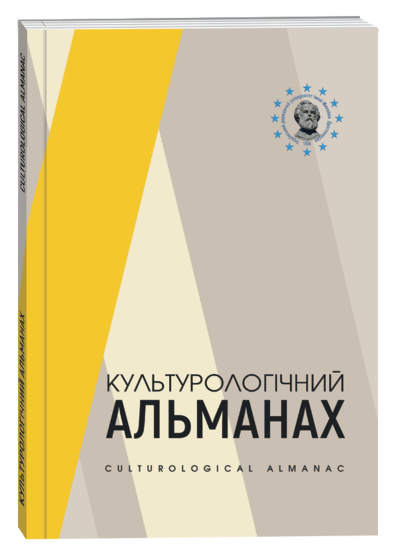MEDIA TRENDS OF MODERN CULTURE
DOI:
https://doi.org/10.31392/cult.alm.2022.3.33Keywords:
trend, culture, media trend, media culture, new media, social media, social networksAbstract
The article examines the factors of cultural changes at the beginning of the 21st century. The method of work is the study of transformational processes in culture and the determination of the main cultural trends that determine these transformations. To achieve the goal, the methodological potential of cultural studies and related sciences was used – the historical method, methods of the empirical level - description and comparison, the method of abstraction, generalization, etc. The guiding principle was the principle of cultural determinism. It is noted that under the influence of scientific and technical innovations, media culture is formed as a multifunctional type of culture of the latest era. Media trends are identified as cultural trends that influence the state of culture and produce qualitatively different forms of its functioning. It is noted that a special role in cultural transformations is played by new media as a new type of communication formed by digital technologies. Social media as a set of Internet services – search engines, messengers, blogs, data exchange services, databases, news sites, social networks – have been identified and analyzed. Social networks were singled out as the leading media trend. The specifics of social networks are studied. Analysis of the essence, socio-cultural potential, evolution of forms and perspectives of the impact of new media on the entire sphere of social life, which allows us to conclude that changes in the traditional model of information dissemination at the beginning of the 21st century are associated with qualitatively new technical innovations and the rapid evolution of the media space. Social media, which shape culture and at the same time become a translator of various cultural assets, inventions of artistic and artistic creativity, have become a cultural trend. Among the new media, the biggest role in cultural transformations is played by social networks, which dominate the fixation of reality events and remain the most popular information channel. Social networks perform many functions, creating a valuable basis for their existence. It was concluded that the outlined trends determine changes in the general direction of cultural development. Their further study will be important not only for understanding the general development of culture, but also will allow predicting and regulating the main challenges in the future.
References
Алфьорова З.І., Алфьоров А.М. (2016). Національне та європейське в сучасній українській медіаосвіті. Культура України. Cерія : Мистецтвознавство. Вип. 53. С. 174–185. URL: http://nbuv.gov.ua/UJRN/Kum_2016_53_20 (дата звернення: 06.08.2019)
Гіллен, П. (2009). Нові агенти впливу. USA: Society for New Communications Research. 2009.
Григорова З. (2017). Нові медіа, соціальні медіа, соціальні мережі – ієрархія інформаційного простору. Технологія і техніка друкарства. № 3(57). С. 93–100.
Зражевська Н. (2013). Нові медіа і нові форми комунікації в медіа культурі. Current issues of mass communication. Issue 14. С. 70–75. URL: http://nbuv.gov.ua/UJRN/apmk_2013_14_16 (дата звернення: 23.10.2022)
Іванов В. (2010). Основні теорії масової комунікації і журналістики. Київ : Центр вільної преси.
Іщенко Н. …Плюс фейсбукізація всієї країни. Якими будуть наслідки наступу нових медіа. День. С. 195–196. URL: https://day.kyiv.ua/uk/article/media/plyus-feysbukizaciya-vsiyeyi-krayiny (дата звернення: 06.05.2020).
Кавєріна А. (2014). Соціальні медіа в Україні: основні напрями досліджень. Вісник НТУУ «КПІ» Політологія. Соціологія. Право. № 2(22). URL: http://visnyk-psp.kpi.ua/article/view/119041/113349 (дата звернення:13.09.2020).
Лавриш Ю. (2018). Жанрова палітра нових медій: специфіка і креативність. Вісник Львівського університету. Вип. 44. С. 239–245.
Меллер К. (2012). Свобода СМИ в социальных сетях и социальных СМИ. От традиционных к сетевым СМИ: Передовая практика и перспективы. 9-ая южнокавказская конференция СМИ. Тбилиси, Грузия, 11-12 октября 2012 г. Вена : Представитель по вопросам свободы СМИ. Организация по безопасности и сотрудничеству в Европе. С. 19–31. URL: http://www.osce.org/ru/fom/102323 (дата звернення: 15.07.2022).
Основи медіаменеджменту / О.М. Барзилович, З.В. Григорова, Л.А. Пунчак та ін. / КПІ ім. Ігоря Сікорського, 2017.
Проценко Д., Тупчієнко Д. (2012). Огляд підходів до регулювання нових конвергентних аудіовізуальних засобів масової інформації: міжнародний досвід. Київ : Національний університет «Києво-Могилянська Академія».
Судакова В., Наумова М. та ін. (2017). Нові медіа в сучасному суспільстві: культурологічний вимір. Київ : Інститут культурології НАМ України.
Cavazza F. (2014). Social Media Landscape. URL: http://www.fredcavazza.net/2014/05/22/social-medialandscape-2014 (дата звернення: 23.10.2022).
Kaplan, A. (2010). User sof the world, unite! The challenges and opportunities of Social Media. Business Horizons. № 53(1). Р. 59–68.
McQuail, D. (2010). Mass Communication Theory. London.
Scott, J. (2000). Social Network Analysis: A Handbook. CA: Sage.
Thornley, J. (2008). What is «social media»? URL: http://propr.ca/2008/what-is-social-media (дата звернення: 17.02.2021).








